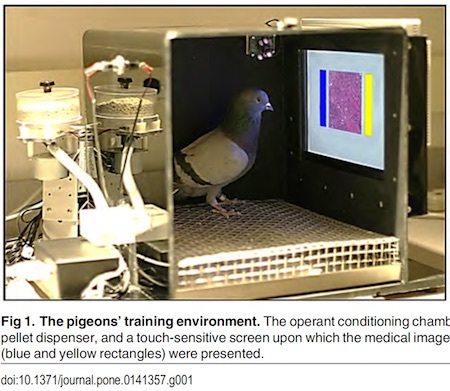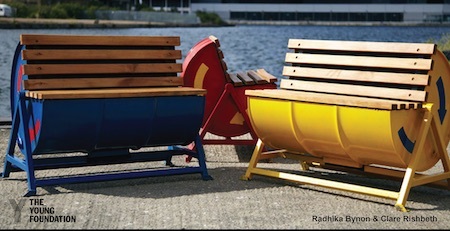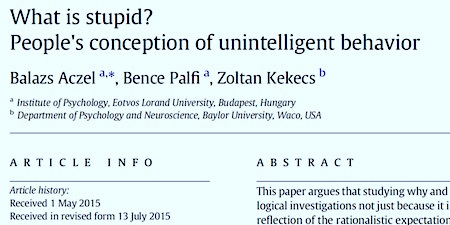Marc Abrahams's Blog, page 295
November 20, 2015
Ellipsis in English Literature
Dr. Anne Toner, of the Faculty of English at Trinity College Cambridge, UK, studies varieties of incompleteness in literary works. She has recently published a book which focusses on a particular incompleteness signifier: Ellipsis in English Literature : Signs of Omission. The publisher notes :
“
Anne Toner provides an original account of the history of ellipsis marks – dots, dashes and asterisks – in English literary writing. Highlighting ever-renewing interest in these forms of non-completion in literature, Toner demonstrates how writers have striven to get closer to the hesitancies and interruptions of spoken language, the indeterminacies of thought, and the successive or fragmented nature of experience by means of these textual symbols.”
Improbable would have liked to have provided more detail about the work, but our attempts to contact both the author and the publisher met with little if any success …
Questions [optional]
• What is the plural form of ‘Ellipsis’ ? Ellipsises or Ellipses?
• Is there a significant difference between three dots . . . and the triple dot glyph … ?
• What is the function of the ‘mid-line’ ellipsis ⋯ ?
• What happens when an ellipsis ends a sentence, is the correct form … . ?

November 19, 2015
The Butcher’s Tongue Illusion (update)
Could we inform those who wish to experiment in a hands-on practical way with the Butcher’s Tongue Illusion (which we highlighted [highlit?] back in Oct 2014, see: ‘The Butcher’s Tongue Illusion (from the chip-crunch manipulator’), that the paper provides a link to DiscountMagic where fake tongues (like the one used in the experiments) can be purchased for £6.50 (+ “Only another £18.50 for free UK shipping”)

November 18, 2015
Pigeons as Trained Observers in the War on Cancer
Pigeons may be as good as some bad radiologists, in some ways, maybe, suggests this new study:
“Pigeons (Columba livia) as Trainable Observers of Pathology and Radiology Breast Cancer Images,” Richard M. Levenson, Elizabeth A. Krupinski, Victor M. Navarro, and Edward A. Wasserman, PLoS ONE, 10(11): e0141357. (Thanks to Ig Nobel Prize winner Elizabeth Oberzaucher for bringing this to our attention.) The authors, at University of California Davis, the University of Iowa, and Emory University, report:
“We report here that pigeons (Columba livia)—which share many visual system properties with humans—can serve as promising surrogate observers of medical images, a capability not previously documented. The birds proved to have a remarkable ability to distinguish benign from malignant human breast histopathology after training with differential food reinforcement; even more importantly, the pigeons were able to generalize what they had learned when confronted with novel image sets. The birds’ histological accuracy, like that of humans, was modestly affected by the presence or absence of color as well as by degrees of image compression, but these impacts could be ameliorated with further training. Turning to radiology, the birds proved to be similarly capable of detecting cancer-relevant microcalcifications on mammogram images. However, when given a different (and for humans quite difficult) task—namely, classification of suspicious mammographic densities (masses)—the pigeons proved to be capable only of image memorization and were unable to successfully generalize when shown novel examples.”
BONUS: The 1995 Ig Nobel Prize for psychology was awarded to Shigeru Watanabe, Junko Sakamoto, and Masumi Wakita, of Keio University, for their success in training pigeons to discriminate between the paintings of Picasso and those of Monet. [details of that research are in the study “Pigeons’ Discrimination of Paintings by Monet and Picasso,” Journal of the Experimental Analysis of Behavior, vol. 63, 1995, pp. 165-174.]
BONUS: Kinect and pigeon behavior, with another look at the video of B.F. Skinner explaining how he trains pigeons:

Podcast #38: Color preference in the insane, with frozen mammoth
Color preference in the insane, the red sweat of the hippopotamus, the question of whether The Explorer’s Club served a dinner of thawed, roast woolley mammoth, and how surgeons handle pop-up surprises — all of these turn up in this week’s Improbable Research podcast.
LISTEN TO IT! …or click on the “Venetian blinds” icon — at the lower right corner here — to select whichever week’s episode you want to hear:
SUBSCRIBE on Play.it, iTunes, or Spotify to get a new episode every week, free.
This week, Marc Abrahams tells about:
Color preference in the insane. (Siegfried E. Katz, 1931,
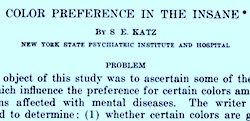 ‘Color Preference in the Insane.’ Journal of Abnormal and Social Psychology 26 (2): 203–11. Featuring dramatic readings by
Jean Berko Gleason
.
)
‘Color Preference in the Insane.’ Journal of Abnormal and Social Psychology 26 (2): 203–11. Featuring dramatic readings by
Jean Berko Gleason
.
)The Red Sweat of the Hippopotamus. (“Refined Structure of Hipposudoric and Norhipposudoric Acids, Pigments of the Red Sweat of the Hippopotamus,”
 Takatoshi Matsumoto, Yoko Saikawa, Masaya Nakata, and Kimiko Hashimoto, Chemistry Letters, epub 2015. Featuring dramatic readings by Richard Baguley.)
Takatoshi Matsumoto, Yoko Saikawa, Masaya Nakata, and Kimiko Hashimoto, Chemistry Letters, epub 2015. Featuring dramatic readings by Richard Baguley.)Did the Explorers Club eat frozen mammoth? (“Was Frozen Mammoth or Giant Ground Sloth Served for Dinner at the Explorers Club?” Matt Davis, Jessica R. Glass, Timothy J. Walsh, Eric J. Sargis, and Adalgisa Caccone, 2015 GSA Annual Meeting in Baltimore, Maryland, USA (1-4 November 2015), Paper No. 327-16. Featuring dramatic readings by Bruce Petschek.)
Some boys-will-be-boys research. (“What to Do If It Gets ‘Bigger’“, C. Kouriefs and N.A. Watkin, Annals of The Royal College of Surgeons of England, vol. 85, no. 2, March 2003, pp. 126–8.
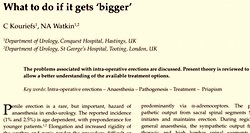 / “Serotonin Transporter Promoter Region (5-HTTLPR) Polymorphism is Associated with the Intravaginal Ejaculation Latency Time in Dutch Men with Lifelong Premature Ejaculation,” Journal of Sexual Medicine, Paddy K.C. Janssen, Steven C. Bakker, Janos Réthelyi, Aeilko H. Zwinderman, Daan J. Touw, Berend Olivier, and Marcel D. Waldinger, vol. 6, 2009, pp. 276–84. / “Effect of Different Types of Textiles on Sexual Activity. Experimental Study,” Ahmed Shafik, European Urology, vol. 24, no. 3, 1993, pp. 375–80. / Excrement in the Late Middle Ages— Sacred Filth and Chaucer’s Fecopoetics, Susan Signe Morrison, Palgrave Macmillan, New York, 2008. /
/ “Serotonin Transporter Promoter Region (5-HTTLPR) Polymorphism is Associated with the Intravaginal Ejaculation Latency Time in Dutch Men with Lifelong Premature Ejaculation,” Journal of Sexual Medicine, Paddy K.C. Janssen, Steven C. Bakker, Janos Réthelyi, Aeilko H. Zwinderman, Daan J. Touw, Berend Olivier, and Marcel D. Waldinger, vol. 6, 2009, pp. 276–84. / “Effect of Different Types of Textiles on Sexual Activity. Experimental Study,” Ahmed Shafik, European Urology, vol. 24, no. 3, 1993, pp. 375–80. / Excrement in the Late Middle Ages— Sacred Filth and Chaucer’s Fecopoetics, Susan Signe Morrison, Palgrave Macmillan, New York, 2008. /
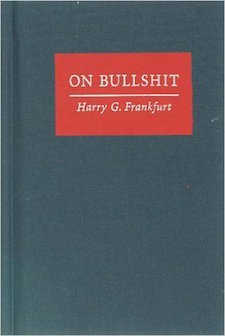 On Bullshit
, Harry G. Frankfurt, Princeton University Press, Princeton, 2005. / “A Kind Word for Bullshit: The Problem of Academic Writing,” Philip Eubanks and John D. Schaeffer, College Composition and Communication, vol. 59, no. 3, February 2008, pp. 272–88. / “Picadura de Anémona en Pene” [article in Spanish], J.M. Janeiro Pais, et al., Actas Urológicas Españolas, vol. 32, no. 8, September 2008, p. 864. Featuring dramatic readings by Richard Baguley.)
On Bullshit
, Harry G. Frankfurt, Princeton University Press, Princeton, 2005. / “A Kind Word for Bullshit: The Problem of Academic Writing,” Philip Eubanks and John D. Schaeffer, College Composition and Communication, vol. 59, no. 3, February 2008, pp. 272–88. / “Picadura de Anémona en Pene” [article in Spanish], J.M. Janeiro Pais, et al., Actas Urológicas Españolas, vol. 32, no. 8, September 2008, p. 864. Featuring dramatic readings by Richard Baguley.)The mysterious John Schedler or the shadowy Bruce Petschek perhaps did the sound engineering this week.
The Improbable Research podcast is all about research that makes people LAUGH, then THINK — real research, about anything and everything, from everywhere —research that may be good or bad, important or trivial, valuable or worthless. CBS distributes it, on the CBS Play.it web site, and on iTunes and Spotify).

November 17, 2015
Supper: Data Karaoke
Karaoke has penetrated to so many levels of society that it has reached even the some of the scientists who present data at scientific conferences. This study, by Supper, tells how that came about:
“Data Karaoke: Sensory and Bodily Skills in Conference Presentations,” Alexandra Supper, [pictured here], Volume 24, Issue 4, 2015, pages 436-457. (Thanks to Tom Gill for bringing this to our attention.) The author, at Maastricht University, explains:
 “At the International Conference on Auditory Display (ICAD), an interdisciplinary conference dedicated to sonification and the use of non-speech sound to represent information, presenters make use of a variety of bodily skills and representations that appeal to the senses of their audience… The practice of ‘data karaoke’, in which researchers mimic the sound of a sonification with their own voice, is particularly instructive…
“At the International Conference on Auditory Display (ICAD), an interdisciplinary conference dedicated to sonification and the use of non-speech sound to represent information, presenters make use of a variety of bodily skills and representations that appeal to the senses of their audience… The practice of ‘data karaoke’, in which researchers mimic the sound of a sonification with their own voice, is particularly instructive…
“To make sense of data karaoke, we have to understand the institutional and intellectual environment in which this peculiar practice has emerged; but conversely, an understanding of data karaoke can help us throw new light on epistemological debates about the hierarchy of the senses: data karaoke is a multisensory skill engaging the whole body of the sonification researcher, and thus calls into question the dominant epistemological discourse within the ICAD community, in which the different sensory modalities are framed as competitors.”
BONUS: Here’s a twist on that: video of Stephen Barrass of the University of Canberra talking about his “Hypertension Singing Bowl“. Barrass says: “The Hypertension Singing Bowl is an Acoustic Sonification shaped by a year of blood pressure data that has been 3D printed in stainless steel so that it rings…. The resulting Hypertension singing bowl is a meditative contemplation on the dataset that is a reminder to live a healthy lifestyle, and a poetic alternative to generic graphic plots of the Quantified Self.”

November 16, 2015
An authoritative answer to the coffee/health question
A question may be difficult (or impossible) to really answer, but that difficulty does not prevent authoritative people from supplying authoritative answers.
A November 16, 2015 press release brews up a new authoritative answer to the question “Is drinking coffee good or bad for your health”:
Moderate coffee drinking may lower risk of premature death
HARVARD T.H. CHAN SCHOOL OF PUBLIC HEALTH
Boston, MA – People who drink about three to five cups of coffee a day may be less likely to die prematurely from some illnesses than those who don’t drink or drink less coffee, according to a new study by Harvard T.H. Chan School of Public Health researchers and colleagues….
“Bioactive compounds in coffee reduce insulin resistance and systematic inflammation,” said first author Ming Ding, a doctoral student in the Department of Nutrition. “That could explain some of our findings. However, more studies are needed to investigate the biological mechanisms producing these effects.”
 The study is: “Association of Coffee Consumption with Total and Cause-specific Mortality in Three Large Prospective Cohorts,” Ming Ding, Ambika Satija, Shilpa N. Bhupathiraju, Yang Hu, Qi Sun, Walter Willett, Rob M. van Dam, Frank B. Hu [pictured here], Circulation, online November 16, 2015.
The study is: “Association of Coffee Consumption with Total and Cause-specific Mortality in Three Large Prospective Cohorts,” Ming Ding, Ambika Satija, Shilpa N. Bhupathiraju, Yang Hu, Qi Sun, Walter Willett, Rob M. van Dam, Frank B. Hu [pictured here], Circulation, online November 16, 2015.
The authors and their institution made a video to inform the public that the coffee question has now been answered:
BONUS ACTIVITY: Read the entire press release, and also the entire study. Count the number of times you see the words “may” or “could“.
BONUS BONUS ACTIVITY: Read several press accounts of this study. For each press account, count the number of times you see the words “may” or “could“. Perhaps begin with these two news reports: “Drink up, coffee’s good for you. (Even decaf!)” and “Coffee could literally be a lifesaver“.
EXTRA BONUS BONUS ACTIVITY, FOR EXTREMELY NERDY READERS ONLY: In the space of one minute (60 seconds), list five reasons why it is difficult or impossible to find the real answer to the question “Is drinking coffee good or bad for your health?”

Algorithm predicts winner of the 2016 U.S. Presidential election
In predicting the winner of the 2016 U.S. presidential election, Eric Schulman and Daniel Debowy again demonstrate the power of statistics — and demonstrate that the power of statistics can be divorced from other qualities of statistics. They created an algorithm (in other words: a mathematical recipe) that accurately, thoughtlessly produces a possibly-meaningless prediction that’s based entirely on genuine facts.
Schulman and Debowy have prepared a new study, called “WHO WILL WIN THE 2016 U.S. PRESIDENTIAL ELECTION?” They have also created a related Facebook page, for everyone who would like to analyze or bloviate.
Here are key snippets of the new study:
The Annals of Improbable Research U.S. Presidential Election Algorithm (Debowy and Schulman 2003) correctly predicted the outcome of the 2004, 2008, and 2012 United States presidential elections. Now that the 2016 campaign for U.S. President has officially started, we apply our proven algorithm to 22 potential Republican candidates and 14 potential Democratic candidates for this election.
ABSTRACT. Our 2003 algorithm for determining the winners of United States presidential elections correctly ascertained the winner of each of the 56 U.S. presidential elections between 1789 and 2000 and correctly predicted the winners of the 2004, 2008, and 2012 U.S. presidential elections. In this paper we apply the algorithm to 22 potential Republican candidates and 14 potential Democratic candidates for the 2016 U.S. presidential election. The Republican candidate with the highest presidential electability is James R. Perry, who suspended his campaign on September 11, 2015. Two Democratic candidates are tied with the highest electability: Lincoln D. Chafee, who ended his campaign on October 23, 2015, and Edmund G. Brown, Jr., who has not declared that he is running.

Personal space gauges (one’s arms)
 Much has been written about the concept of ‘proxemics‘ and the notional invisible bubble that can be used to depict one’s ‘personal space’. But how big is the bubble? And is there a simple and reliable way to measure it? Italian researchers Nicola Bruno (Dipartimento di Neuroscienze, Unità di Psicologia, Università di Parma) and Michela Muzzolini (Dipartimento di Scienze della Vita, Unità di Psicologia ‘Gaetano Kaniza’, Trieste) suggest that there might be. The length of one’s arms. In what is believed to be the first experimental study to assess the effect of body size on proxemic personal space, the team found that :
Much has been written about the concept of ‘proxemics‘ and the notional invisible bubble that can be used to depict one’s ‘personal space’. But how big is the bubble? And is there a simple and reliable way to measure it? Italian researchers Nicola Bruno (Dipartimento di Neuroscienze, Unità di Psicologia, Università di Parma) and Michela Muzzolini (Dipartimento di Scienze della Vita, Unità di Psicologia ‘Gaetano Kaniza’, Trieste) suggest that there might be. The length of one’s arms. In what is believed to be the first experimental study to assess the effect of body size on proxemic personal space, the team found that :
“In same-sex interactions, personal distance was modulated by arms length, independently of sex. The longer the arms of the participant, the larger the distance in both men and women. “
And/but with a previously undiscovered twist:
“In different-sex interactions, however, personal distance was modulated by the similarity of participant and confederate arm length. Both men and women participants kept at closer distances when their arms were more similar to their confederate’s arms, and at longer distances when they were more different.”
See: ‘Proxemics Revisited: Similar Effects of Arms Length on
Men’s and Women’s Personal Distances’ Universal Journal of Psychology, 1(2): 46-52.

November 15, 2015
Discovery: The park bench
A discovery about park benches leaps from a press release from the University of Sheffield:
Researchers in the University’s Department of Landscape and the London-based think tank, found that sitting on benches allows people to spend longer outside
The press release goes on to explain that this property of benches “is both beneficial for mental health and allows people to connect with others in their community.” Further details of the research appear in a study called “Benches for everyone,” by Radhika Bynon and Clare Rishbeth, published by The Young Foundation.
Here’s a snippet from that paper:
Fitz, a teenager, sitting up on the back of the benches with his friends said “if you spent longer than a week in Woolwich, yeah, you would see so much stuff, you’d just see everything”. By observing difference in this way, people spoke about how they develop an awareness of a broader range of behaviours and activities, helping to engender greater tolerance. This high-density location also plays host to a wide network of ‘loose ties’, flexibly accommodating the churn of neighbourhood population change, and allowing participation and a sense of belonging without making demands.
(Thanks to investigator John Pullin for bringing this to our attention.)

November 13, 2015
What is stupid(ity)?
Despite many decades (or some might say centuries) of concerted scholarly effort towards answering the question ‘What is intelligence?’ there still isn’t an answer that everyone can agree on. Perhaps then, the time has come to tackle the problem from another direction and ask instead ‘What is stupid(ity)?’ ?
A team of researchers from the Institute of Psychology, Eötvös Loránd University, Budapest, Hungary and the Department of Psychology and Neuroscience, Baylor University, Waco, US, ask, and attempt to answer, just such a question in the Nov-Dec 2015 issue of the scholarly journal Intelligence, see: ‘What is stupid?: People’s conception of unintelligent behavior’.
Lead researcher Dr Balázs Aczél [pictured] and colleagues asked experimental  participants to fill in questionnaires and rate stories retrieved from popular internet sources found via searches of “stupid thing to”, “stupidity”, “it was stupid of”, “it was very stupid” and “stupid”. As a result of their analyses, the team conclude that
participants to fill in questionnaires and rate stories retrieved from popular internet sources found via searches of “stupid thing to”, “stupidity”, “it was stupid of”, “it was very stupid” and “stupid”. As a result of their analyses, the team conclude that
“[…] people use the label stupid for three separate types of situation: (1) violations of maintaining a balance between confidence and abilities; (2) failures of attention; and (3) lack of control. The level of observed stupidity was always amplified by higher responsibility being attributed to the actor and by the severity of the consequences of the action. These results bring us closer to understanding people’s conception of unintelligent behavior while emphasizing the broader psychological perspectives of studying the attribute of stupid in everyday life.”
But sadly, those hoping for a firm and succinct definition of the concept won’t find one here, and, (bearing in mind the comparative scarcity of stupidity research to date) the team note :
“As a first empirical exploration of this topic, this study naturally comes with a number of limitations and opens several questions to be answered. Since we collected stories from popular internet websites and only used local raters, it remains unanswered how much is the concept of stupid and to what extent are the monitoring functions culturally specific.”
A full copy of the paper may be found here.
Further explorations:
▪ Organization Studies and Stupidity
▪ Stupid stories and subsequent stupidity
Bonus: Paul Sandby’s Coelum ipsum petimus stultitia, a giant exploding balloon; 1784

Marc Abrahams's Blog
- Marc Abrahams's profile
- 14 followers


